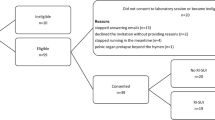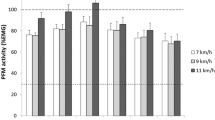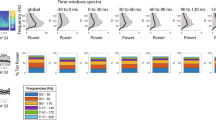Abstract
Introduction and hypothesis
To date, no study has investigated the correlation between pelvic floor muscle function and urinary incontinence in female runners. The aim of the study was to investigate the relationship between pelvic floor muscle function and to correlate urinary leakage as measured by the modified pad test with kinematic variables of running.
Methods
The sample consisted of 11 incontinent and 17 continent runners. On day 1, they performed a maximum velocity test on a treadmill using an incremental protocol. Their pelvic floor muscles were evaluated using vaginal palpation and manometry, and the adapted pad test was used to evaluate the severity of urinary incontinence. Then, running kinematics were evaluated on a treadmill using a circuit camera to capture vertical displacement, knee flexion during the load response phase, and the initial contact of the foot with the ground for subsequent analysis. The pad test was performed during the kinematic evaluation.
Results
The vaginal squeeze pressure of the continent group (mean = 43.40 mmHg, SD = 21.75) was higher in descriptive terms than that of the incontinent group (mean = 38.94 mmHg, SD = 31.08), but the difference was not statistically significant (p = 0.66). There was an association between the weekly training load and urinary leakage. No associations were found between pelvic floor muscle function or urinary leakage and the kinematic variables.
Conclusions
Despite the correlation between the weekly training load and the severity of urinary leakage, no relationships were found between pelvic floor muscle functioning and the kinematics of running.




Similar content being viewed by others
Abbreviations
- AI:
-
Athletic incontinence
- BMI:
-
Body mass index
- CG:
-
Continent group
- ICC:
-
Intraclass correlation coefficient
- IG:
-
Incontinent group
- ICIQ-SF:
-
International Consultation on Incontinence Questionnaire—Short Form
- ICS:
-
International Continence Society
- IU:
-
Urinary incontinence
- PF:
-
Pelvic floor
- PFMs:
-
Pelvic floor muscles
- SUI:
-
Stress urinary incontinence
References
Leitner M, Moser H, Eichelberger P, et al. Evaluation of pelvic floor muscle activity during running in continent and incontinent women: an exploratory study. Neurourol Urodyn. 2017;36(6):1570–6.
Haskell W, Lee I-M, Pate R, et al. Physical activity and public health: updated recommendation for adults from the American College of Sports Medicine and the American Heart Association. Circulation. 2007;116(9):1081–93.
Araújo M, Oliveira E, Zucchi E, et al. Relação entre incontinência urinária em mulheres atletas corredoras de longa distância e distúrbio alimentar. Rev Assoc Med Bras. 2008;54(2):146–9.
Fozzatti C, Riccetto C, Herrmann V, et al. Prevalence study of stress urinary incontinence in women who perform high-impact exercises. Int Urogynecol J Pelvic Floor Dysfunct. 2012;23(12):1687–91.
Haylen BT, Freeman RM, Swift SE, Cosson M, Davila GW, et al. An international Urogynecological association (IUGA) / international continence society (ICS)joint terminology and classification of the complications related directly to the insertion of prostheses (meshes, implants, tapes) & grafts in female pelvic floor surgery. Int Urogynecol J. 2011;22:3–15. https://doi.org/10.1007/s00192-010-1324-9.
Almeida M, Barra A, Saltiel F, et al. Urinary incontinence and other pelvic floor dysfunctions in female athletes in Brazil: a cross-sectional study. Scand J Med Sci Sports. 2015;26(9):1109–16.
Ree M, Nygaard I, Bo K. Muscular fatigue in the pelvic floor muscles after strenuous physical activity. Acta Obstet Gynecol Scand. 2007;86(7):870–6.
Araujo MP, Sartori MG, Girão MJ. Athletic incontinence: proposal of a new term for a new woman. Rev Bras Ginecol Obstet 2017;39(9):441–2. https://doi.org/10.1055/s-0037-1605370.
Gottschall JS, Kram R. Ground reaction forces during downhill and uphill running. J Biomech. 2005;38(3):445–52.
Nygaard I, Delancey J, Arnsdorf L, Murphy E. Exercise and incontinence. Obstet Gynecol. 1990;75(5):848–51.
Novacheck T. The biomechanics of running. Gait Posture. 1998;7(1):77–95.
Davis IS, Bowser BJ, Mullineaux DR. Greater vertical impact loading in female runners with medically diagnosed injuries: a prospective investigation. Br J Sports Med. 2016;50(14):887–92.
Cohen J. Statistical power analysis for the behavioral sciences, 2nd edition. Hillsdale: Lawrence Erlbaum; 1988.
Tamanini JT, Dambros M, D’Ancona CA, et al. Validação para o português do International Consultation on Incontinence Questionnaire—Short Form (ICIQ-SF). Rev Saúde Pública. 2004;38(3):438–44.
Peserico CS, Zagatto AM, Machado FA. Evaluation of the best-designed graded exercise test to assess peak treadmill speed. Int J Sports Med. 2015;36(9):729–34.
Kuipers H, Rietjens G, Verstappen F, et al. Effects of stage duration in incremental running tests on physiological variables. Int J Sports Med. 2006;24(7):486–91.
Borg GA. Psychophysical bases of perceived exertion. Med Sci Sports Exerc. 1982;14(5):377–81.
Bø K, Finckenhagen HB. Vaginal palpation of pelvic floor muscle strength: inter-test reproducibility and comparison between palpation and vaginal squeeze pressure. Acta Obstet Gynecol Scand. 2001;80(10):883–7.
Bø K, Sherburn M. Evaluation of female pelvic-floor muscle function and strength. Phys Ther. 2005;85(3):269–82.
Bø K. Pelvic floor muscle training is effective in treatment of female stress urinary incontinence, but how does it work? Int Urogynecol J. 2004;15:76–84.
Frawley HC, Galea MP, Phillips BA, Sherburn M, Bo K. Reliability of pelvic floor muscle strength assessment using different test positions and tools. Neurourol Urodyn. 2006;25:236–42.
Fleiss J. The measurement of interrater agreement: statistical methods for rates and proportions. New York: Wiley; 1981.
Dumoulin C, Morin M, Mayrand M, et al. Group physiotherapy compared to individual physiotherapy to treat urinary incontinence in aging women: study protocol for a randomized controlled trial. Trials. 2017;18:544.
Karantanis E, Allen W, Stervermuer T, et al. The repeatability of 24-hour pad test. Int Urogynecol J. 2005;16:63–8.
Abrams P, Cardozo L, Fall M, et al. The standardization of terminology of lower urinary tract function: report from the standardization sub-committee of the International Continence Society. Neurourol Urodyn. 2002;21:167–78.
Siltberg H, Victor A, Larsson G. Pad weighing tests: the best way to quantify urine loss in patients with incontinence. Acta Obstet Gynecol Scand Suppl. 1997;16(6):28–32.
Da Roza T, Brandao S, Mascarenhas T, et al. Volume of training and the ranking level are associated with the leakage of urine in young female trampolinists. Clin J Sport Med. 2015;25(3):270–5.
Da Roza T, Brandao S, Mascarenhas T, et al. Urinary incontinence and levels of regular physical exercise in young women. Int J Sports Med. 2015;36(9):776–80.
Schabort EJ, Hopkins WG, Hawley JA. Reproducibility of self-paced treadmill performance of trained endurance runners. Int J Sports Med. 1998;19(1):48–51.
Iguana Sports. (2014) A primeira pesquisa sobre a corrida feminina no Brasil. Available at: <http://www.suacorrida.com.br/dnadecorredora/apres/dna_de_corredora_2014.pdf>. Accessed on: 20 August 2017.
Da Roza T, de Araujo MP, Viana R, et al. Pelvic floor muscle training to improve urinary incontinence in young, nulliparous sport students: a pilot study. Int Urogynecol J. 2012;23(8):1069–73.
Bø K. Urinary incontinence, pelvic floor dysfunction, exercise and sport. Sports Med. 2004;34(7):451–64.
Funding
National Council for Scientific and Technological Development (CNPq), process number: 134141/2017-2.
Author information
Authors and Affiliations
Corresponding author
Ethics declarations
Conflicts of interest
None.
Additional information
Publisher’s note
Springer Nature remains neutral with regard to jurisdictional claims in published maps and institutional affiliations.
Rights and permissions
About this article
Cite this article
de Melo Silva, R., Rodrigues, M.E.S., Puga, G.M. et al. The relationship between running kinematics and the pelvic floor muscle function of female runners. Int Urogynecol J 31, 155–163 (2020). https://doi.org/10.1007/s00192-019-03968-z
Received:
Accepted:
Published:
Issue Date:
DOI: https://doi.org/10.1007/s00192-019-03968-z




